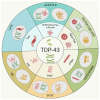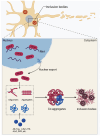Co-Aggregation of TDP-43 with Other Pathogenic Proteins and Their Co-Pathologies in Neurodegenerative Diseases
- PMID: 39596445
- PMCID: PMC11594478
- DOI: 10.3390/ijms252212380
Co-Aggregation of TDP-43 with Other Pathogenic Proteins and Their Co-Pathologies in Neurodegenerative Diseases
Abstract
Pathological aggregation of a specific protein into insoluble aggregates is a common hallmark of various neurodegenerative diseases (NDDs). In the earlier literature, each NDD is characterized by the aggregation of one or two pathogenic proteins, which can serve as disease-specific biomarkers. The aggregation of these specific proteins is thought to be a major cause of or deleterious result in most NDDs. However, accumulating evidence shows that a pathogenic protein can interact and co-aggregate with other pathogenic proteins in different NDDs, thereby contributing to disease onset and progression synergistically. During the past years, more than one type of NDD has been found to co-exist in some individuals, which may increase the complexity and pathogenicity of these diseases. This article reviews and discusses the biochemical characteristics and molecular mechanisms underlying the co-aggregation and co-pathologies associated with TDP-43 pathology. The TDP-43 aggregates, as a hallmark of amyotrophic lateral sclerosis (ALS) and frontotemporal lobar degeneration (FTLD), can often be detected in other NDDs, such as Alzheimer's disease (AD), Parkinson's disease (PD), Huntington's disease (HD) and spinocerebellar ataxia type 2 (SCA2). In many cases, TDP-43 is shown to interact and co-aggregate with multiple pathogenic proteins in vitro and in vivo. Furthermore, the co-occurrence and co-aggregation of TDP-43 with other pathogenic proteins have important consequences that may aggravate the diseases. Thus, the current viewpoint that the co-aggregation of TDP-43 with other pathogenic proteins in NDDs and their relevance to disease progression may gain insights into the patho-mechanisms and therapeutic potential of various NDDs.
Keywords: TDP-43 pathology; co-aggregation; co-pathology; neurodegenerative disease; pathogenic protein.
Conflict of interest statement
The authors declare no conflicts of interest.
Figures


Similar articles
-
Annexin A11 aggregation in FTLD-TDP type C and related neurodegenerative disease proteinopathies.Acta Neuropathol. 2024 Jun 19;147(1):104. doi: 10.1007/s00401-024-02753-7. Acta Neuropathol. 2024. PMID: 38896345 Free PMC article.
-
Antibody against TDP-43 phosphorylated at serine 375 suggests conformational differences of TDP-43 aggregates among FTLD-TDP subtypes.Acta Neuropathol. 2020 Nov;140(5):645-658. doi: 10.1007/s00401-020-02207-w. Epub 2020 Aug 10. Acta Neuropathol. 2020. PMID: 32778941 Free PMC article.
-
Reappraisal of the anatomical spreading and propagation hypothesis about TDP-43 aggregation in amyotrophic lateral sclerosis and frontotemporal lobar degeneration.Neuropathology. 2020 Oct;40(5):426-435. doi: 10.1111/neup.12644. Epub 2020 Mar 10. Neuropathology. 2020. PMID: 32157757 Review.
-
Interactions of pathological proteins in neurodegenerative diseases.Acta Neuropathol. 2017 Aug;134(2):187-205. doi: 10.1007/s00401-017-1709-7. Epub 2017 Apr 11. Acta Neuropathol. 2017. PMID: 28401333 Free PMC article. Review.
-
Lysosome dysfunction as a cause of neurodegenerative diseases: Lessons from frontotemporal dementia and amyotrophic lateral sclerosis.Neurobiol Dis. 2021 Jul;154:105360. doi: 10.1016/j.nbd.2021.105360. Epub 2021 Mar 31. Neurobiol Dis. 2021. PMID: 33812000 Free PMC article. Review.
Cited by
-
Concomitant Pathologies and Their Impact on Parkinson Disease: A Narrative Overview of Current Evidence.Int J Mol Sci. 2025 Mar 24;26(7):2942. doi: 10.3390/ijms26072942. Int J Mol Sci. 2025. PMID: 40243562 Free PMC article. Review.
-
Looking into Abnormal Co-Expressions of Tau and TDP-43 in the Realm of Mixed Dementia Types: A Double-Punch Scenario.Brain Sci. 2025 Jul 3;15(7):716. doi: 10.3390/brainsci15070716. Brain Sci. 2025. PMID: 40722308 Free PMC article. Review.
References
Publication types
MeSH terms
Substances
Grants and funding
LinkOut - more resources
Full Text Sources
Medical
Research Materials
Miscellaneous

